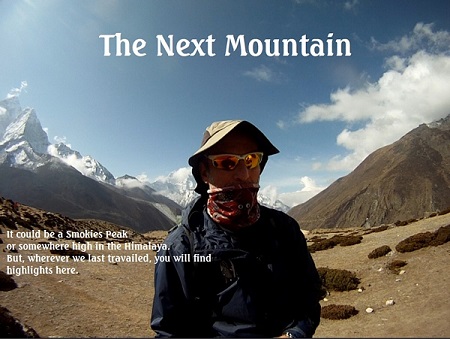Finding East Tennessee’s place on the edge of a South American volcano
Wind sandpapered snow across our faces as we experienced yet another false summit. I quit peering skyward since every prominence seemed to just birth another. Stars so brilliant five hours ago were supplanted by abject whiteness. Icicle caverns brushed the shoulder of Karlyn Zandstra, a nurse practitioner from Norris who is the middle person on our rope. What a strange place to find herself in such horrible conditions 19,000 feet high on the side of an active volcano. Karlyn signed on this expedition to find out what if felt like to experience this altitude. She was getting a full measure.
Crevasses lurked just below the surface of this brittle snow. Our feet were invisible and so were any potential slits in the glacier. For that reason, we divided into three-person rope units. Greenback native Steve McQueen was trailing us under the supervision of a local guide. He finally decided that this man, now entrusted with his life, was a liar. Every time he was told one more hour to the top, “…I swear to God it was two. They don’t let us take long enough breaks,” he lamented while shouting across the deafening gale. I gently reminded my friend that this climb was partly his idea. This kind of climbing is a world away from a hike up Mt. LeConte.
It started innocently enough at the Crag last fall. Steve and several others peppered me with questions about mountaineering while scaling the quarried limestone at a whopping altitude of 850 feet. “It can’t be that bad if you did it,” one told me. I vowed to teach them a lesson.
My proposal, modest seeming at the time, was to take this show on the road: “Let’s go climb volcanoes in Ecuador.” Sara Whitt, a Grainger County native and Knoxville resident, perked up. Her belayer, John Creasy, a Texas boy transplanted to Knoxville, was keen to hear more. Having climbed these peaks 17 years ago seemed all the reassurance my stalwart friends required. Like a low-angle avalanche, this expedition began to snowball. Before long, tickets were booked, and nine of us headed south toward the Ecuadorian volcanoes with our eye on Cotopaxi, an active volcano at 19,347 feet. We touched down in the city of Quito at an elevation of 9,200 feet, only 10,000 shy of our goal. Their punishment had just begun.

None of the charm of this capital city was lost on our group, now dubbed “Team Climb Ax.” From the roof of an open-air bus, we motored through this rainy metropolis and soaked in the visual feast laid before us in the “Valley of the Volcans.” My brother, Todd Quillen, and friend, Greg Moore, from Morristown, tagged along with alternate sightseeing goals.
Headaches abounded in thinner air as we climbed steps around the old town square. Carnival—the celebration leading up to Lent—was in full swing, and here in Ecuador there are government holidays allowing locals to fully participate. Naturally, pranks were focused on the obvious group of gringos. Caleb Kyser, a native Knoxvillian, was greeted with black ash thrown at his face, as I was welcomed with shaving cream to mine, compliments of local school children. This was our relaxation day. True suffering wasn’t supposed to commence until we set foot on our first volcano the following day.
One of our local guides, Pedro, from the hill region outside of Quito, wasn’t faring too well on the approach to our first volcano. He made an earnest run up a slick hillside an hour outside of town, but his minivan was having none of it. We reversed for almost a quarter of a mile and made a second stab. Offloading weight—me—he was finally able to crest the berm and park as we began our first hike a mile earlier than expected. Chickens pecked at our feet as we forked over dollars to someone in a hut with a bathroom that required filling a bucket to flush.
Rain chased us on this first hike as we gained 2,598 feet to the fore-summit of Pasochoa, an extinct volcano. The sweeping views I touted from my last trip down here seemed like a lie. “It was 17 years ago, and in the summer,” I demurred. Nothing seemed familiar, but the pain of agonizing ascent. Our group photographer, Kevin Flint, wasn’t getting those much-anticipated cover shots. A native to Kentucky, Kevin eventually settled into the hills of Tennessee, but his photography has taken him around the world to exotic climbing locations. However, like most of our group, this was his first time in South America.
We made our first summit in the clouds after 4.6 miles. Acclimating to these heights requires climbing a few thousand feet and returning to a lower altitude to help the body adjust to thinning air. Our plan to first scale two smaller volcanoes was time tested. Without doing so, we would never have attempted almost 20,000 feet within a week. Team Climb Ax committed to celebrate upon descent in traditional Ecuadorian fashion: we were off to eat some guinea pig.
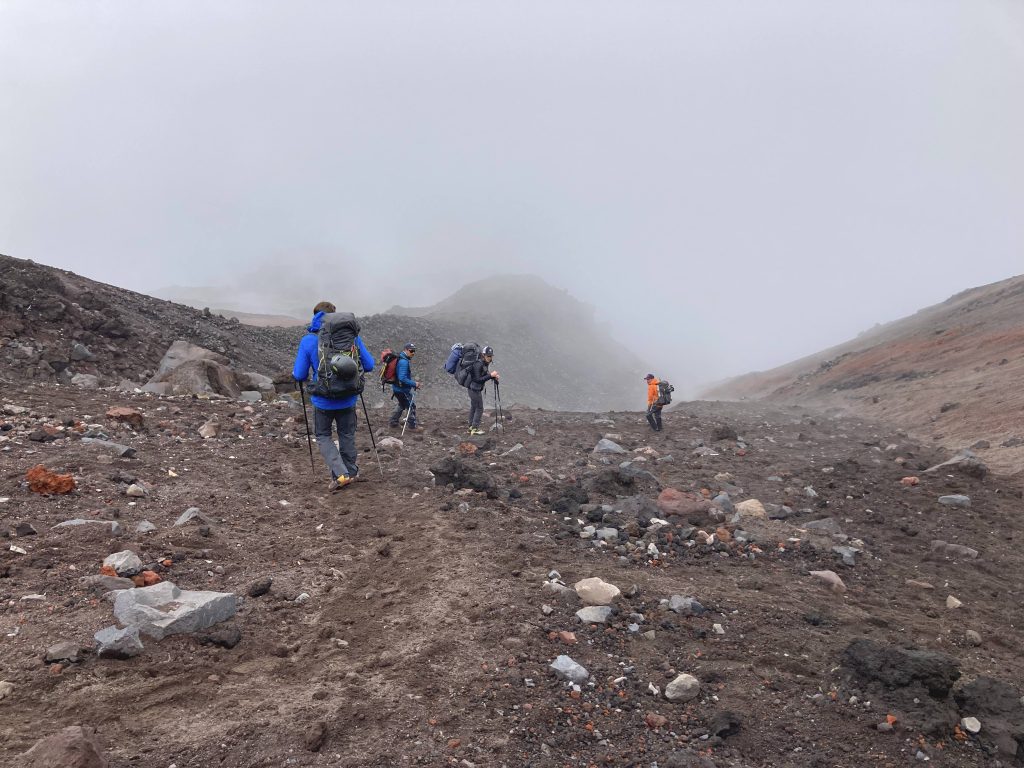
Cuy was a delicacy wasted on our group. Once gathered back at his van, Pedro navigated our victorious team to his favorite eatery along the road back toward town. While we gnawed our way through this shoe leather, we tried to ignore the nose and teeth eyeballing us from our plates. Having tagged some altitude, a rest day was earned. That night, Todd and Greg greeted our muddy assemblage to share tales from their Uber-assisted equatorial foray, known locally as Mitad del Mundo. Apparently, toilet water really doesn’t swirl on the line down there.
Rucu Pichincha was next in our sights, topping out at 15,300 feet. We once again bravely handed our destiny to the care of Pedro and his minivan. Weaving the upper flank of the capital city the bus rounded hairpin after hairpin, dodging livestock and llamas. Black clouds and rain followed us up another peak as we started at the terminus of a gondola now depositing tourists at a mountaintop café. More than one comment was made about why we didn’t choose this method of ascent as we disappeared into the sky and began hiking above this ancient city.
Clouds broke on occasion revealing layers of the valley’s elusive magnificence. Sara and John relished the rock scrambling sections, reminiscent of our time harnessed up in Knoxville. John is a triathlete, so I wasn’t concerned about his level of fitness or any of the group for that matter. An engineer by trade, he travels the world inspecting nuclear power plants. John tried to blame this expedition on Sara, our resident artist and team name progenitor. However, he obviously enjoys overseas adventures, having climbed volcanoes in Bolivia. Scree slopes made for dicey footing but in the sleet we topped out smiling on Rucu Pichincha as a team. This would be the elevation from which we would launch our Cotopaxi ascent in just a couple of days. We still had a long way to go.
One of the best things about a summit is dropping back into thicker air. Karlyn and Steve were ticking off volcanoes as if they were strolling up Knoxville’s House Mountain. Steve is a physician’s assistant and shared Karlyn’s curiosity about the physiological impact of altitude. Having been to Ecuador once and seeing Cotopaxi, his desire to return was the impetus for our journey. He’s also a smart-aleck. Perhaps it had something to do with making him sign a waiver for me prior to our journey. With each unexpected occurrence, I would hear, “I’m going to sue John Quillen Adventures for,” weather, guinea pig teeth, open air bus, rain, sleet. You name it; it made the list.
A fresh group of local guides collected us from our comfortable hotel in the capital. In two four-wheel drive trucks we smashed gear and bodies for a ride to TamboPaxi lodge the following morning. Perched at 12,500 feet, it serves as an intermediate acclimatization point. Nested in the shadow of our pyramidal spire, (which translated means “neck of the moon”), Cotopaxi can be seen holding the planet in its perfectly shaped cone under perfect conditions.
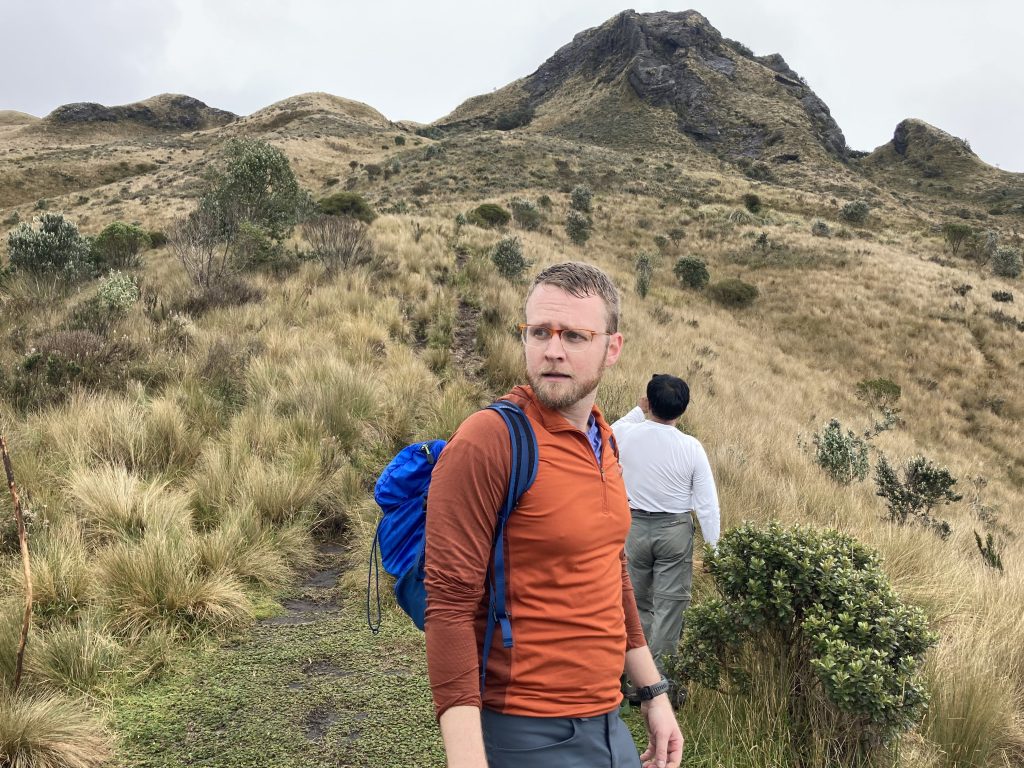
The idea here was to rest before our ultimate ascent. Some interpreted that to mean horseback riding in our now trademark rainstorm. Team Climb Ax saddled up and set off undeterred. But a momentary glimpse of our objective flashed for a few seconds between clouds as they disappeared in chaps across the paramo. Cotopaxi was luring us skyward.
Following lunch the next day, we drove to the base of the massif, donned full packs and sweated for an hour. Kevin shuddered under the weight of two backpacks, one full of photography gear. A new local guide was quick to assist him to the Jose Rivas Refugio. This hut was our last stop before suiting up for the glacier at midnight. It’s fairly typical for alpine ascents to begin at night; the glacier is more frozen and stable. All we had time to do was eat a quick dinner prepared for us and bed down in a bunk reminiscent of a Smokies shelter. We had no more fallen asleep at 6 p.m. before the dreaded 11 p.m. wake up occurred. My team laid out their climbing kit, sorted and resorted gear and tried not to look nervous. “This will be the toughest night of your life,” I warned.
Nine hours into the ascent an unmistakable sulfur smell emanated from the volcano caldera. To Caleb it signified the trapdoor into hell. His face, unrecognizable save for a set of swollen eyes barely visible between a helmet and balaclava, was wind-chapped. This home builder by trade was questioning his sanity. One of our group had already abandoned their discomfort and stopped their ascent at 17,000 feet. That was four hours ago. Visibility was near zero at this point, and the summit must have seemed to my dwindling team another fabrication.
John and Kevin lumbered past the rope Karlyn and I shared. Their local guide was keen to drag them to the crater before anyone else surrendered. It was now 6:25 a.m. in this hazy, apocalyptic snowscape. The putridity from Cotopaxi’s summit reminded me this thing could blow at any time. In fact, following my first 2005 ascent, Cotopaxi erupted in 2016 scouring this route into something entirely unrecognizable, were I actually able to see it.
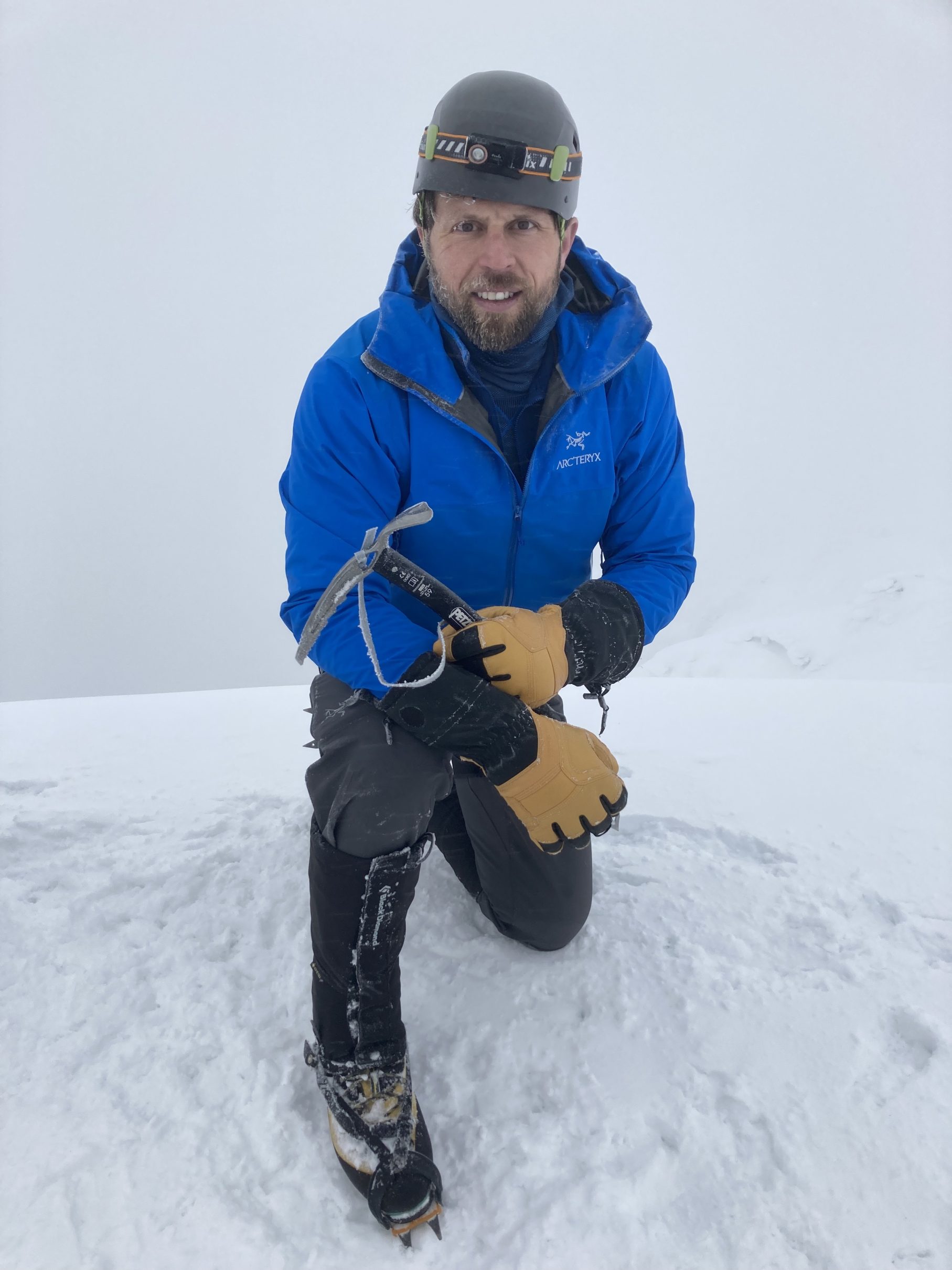
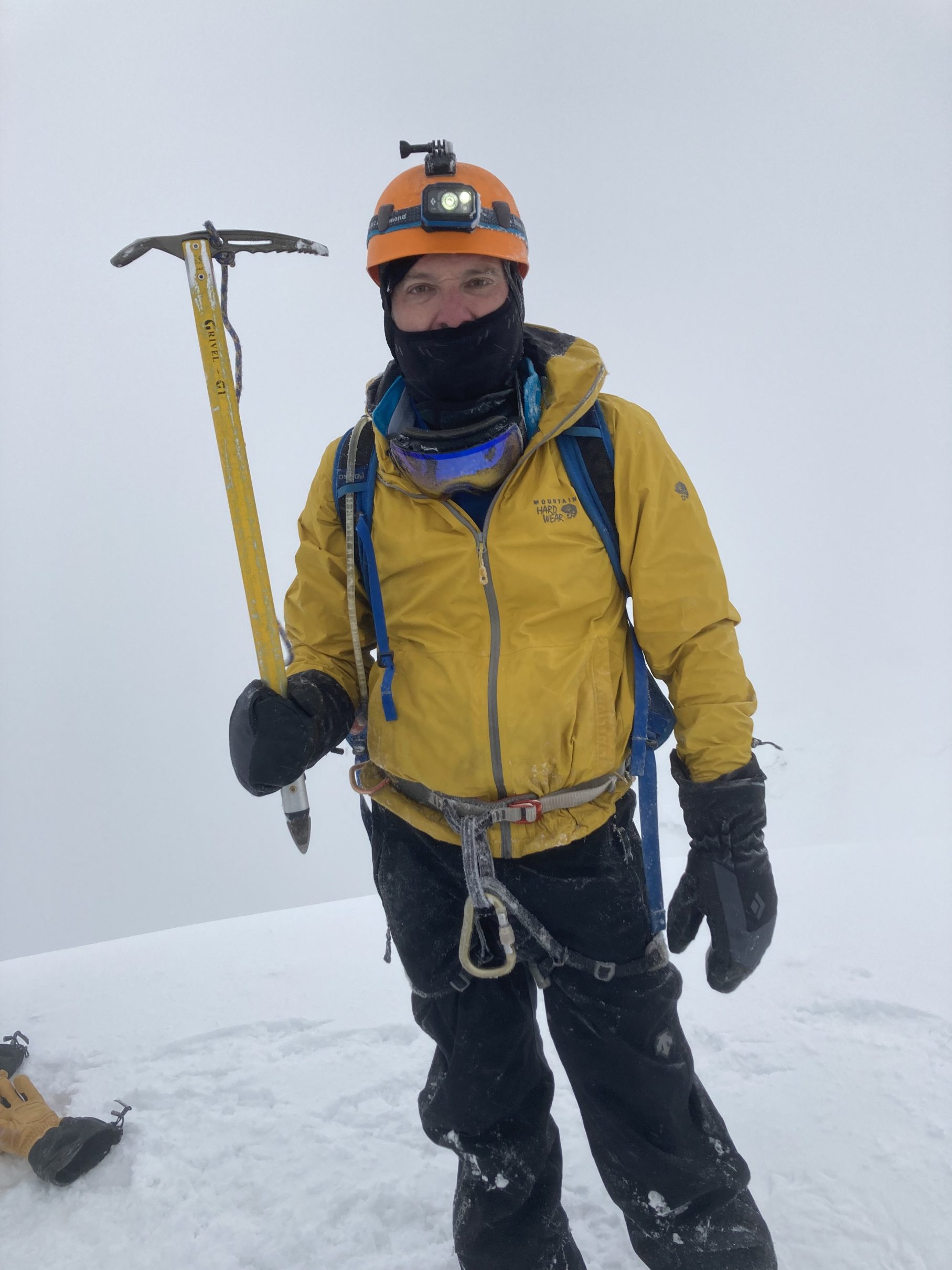
Little fanfare heralded our final steps to the caldera at 19,347 feet. Scant evidence indicated the summit of my memory from 2005, conditions were that abysmal. Team Climb Ax had the mountain to ourselves. Our strongest guys laid down over their packs, panting. Icicles hung from Karlyn’s helmet in the form of frozen hair. The guys panted through fleece-covered mouths. I lost some feeling in my hands and dug out the mittens. No more layers were forthcoming from my pack; I was wearing everything. Beneath the pain and suffering of our team were eyes conveying collective disbelief.
“Congratulations,” I fist-bumped them, inadvertently calling this mountain by another name. Hypoxia knows no bounds. Celebrating was traded for escape.
If you’ve never descended a glacier in 12-point crampons, the learning curve is both immediate and unforgiving. A competition ensued for style points as to who could trip most creatively without jerking the rest of their rope team face first. And all three groups took our turn. “That’s the hardest thing I’ve ever done,” Steve confessed as we zig-zagged the lower snowfields prior to the Refugio. By the look on everyone’s faces, he spoke for the team. “I’m glad I never have to do this again,” added Karlyn.
Over a celebratory dinner back in Quito, we were reunited with Todd and Greg fresh off a Galapagos excursion. Their tan contrasted our peeling faces from the wind. Sitting around the table were two remarkably distinct experiences, together building a picture of all that this part of Ecuador has to offer.
Once showered and back in the thick air, I was already being asked about “that other volcano in Mexico.” Amnesia is an important skill set in the mountaineering game.
A satisfied soaking in thermal hot springs our final day had this Knoxville group already planning the next ascent. They took all the volcano could throw at them and definitely earned the right to suffer some more.
John is a self-described orophile whose mountain addiction has taken him across the globe in search of fresh peak experiences. After completing all the Smokies trails, he sought high points both obscure and well known. With two remaining, he hopes to become the first Tennessean to complete the global Seven Summits.
PREV POST



